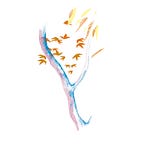Sensory Storyteller
The story of the first woman firefighting pilot
Capturing Mary Barr’s story as the first woman firefighting pilot to work for the National Forest service in 1974 requires multiple sensory experiences for the visitor to fully understand the difficulties and travails she went through.
The story is accounted from her two daughter’s Molly and Nevada Barr and is an outside perspective on her amazing feats. They recount that Mary Barr was fearless and always strived to perform twice as good to prove herself as a pilot.
Main Themes of the story:
The pressure set on women in male dominated industries
- “Any time a woman goes out and does what she wants to and succeeds, it makes it easier.” — Molly Bar
- “[S]he knew for a fact that as a female pilot, she had to be twice as good, twice as calm in the face of upsets to get anywhere.” — Nevada Bar
- “It is very difficult to shake the feeling of always being under a microscope. In military aviation, pilots are constantly evaluated in all that we do — training flights, squadron presentations, you name it. Being one of just five female pilots in a squadron of 200+, my performance is highlighted since I stand out. I sometimes interact with men who have never worked or flown with a female pilot before, and that puts added pressure on me to make a good impression. I feel like if I do well, those men will have a positive impression of female pilots, but if I mess up, they will project my mistake onto female aviators as a whole.” — Caitlin, Pilot
The courage of emergency service workers.
- “She would fly down as close into the forest fires as she could get … I mean… just scary as hell, but momma just thought it was great.” — Nevada Bar
I understood from the story that the main focus should be about the expectations and pressure women have in male-dominated industries. Because this experience is not experienced by all people, I wanted to create a sensory storyteller that allows others to understand this feeling.
Idea Brain-dump:
Wildfire game mechanics:
- Flames and putting out water, if the flames to your character/you then you die. Some sort of reference to “need to be twice as good as the male pilots”. Perhaps a handicap or higher score you need to reach for women.
Game Exterior Concept:
- Airplane game of a 3D landscape and aircraft handles
- Move a physical airplane up and down. The further down u go the hotter but more effective at putting out the fire, further up then less affective at putting out fire but cooler.
Sketched Ideas:
- Aviator game with a physical plane you move to avoid flames projected on a screen behind it.
- Standing or ”flying” over the forest fire—experience how scary it is
- See your reflection crowded by other male (taller) fire-fighters
- Enter a plane and experience the game with a camera projecting your actions to the people outside
- Modified VR headset that is attached to the ceiling. Requires the player to move physically up and down to avoid the fire.
- Aviator simulation in a glass bubble with spectators to add pressure
Mood Board
Layout Sketch
Storyboard
The game mimics the experience of women in a male dominated field. There is immense pressure to perform well since their actions will reflect upon the perception of women and will make it more difficult for future women in the field. The people playing the game afterward a failed game will have a more difficult game because reversing preconceptions is harder once there is evidence or proof of the assumption.
Then I did a storyboard of the game. I decided to split the game into two mini games so that the game play made sense. Since before I was envisioning the game as a 3D plane simulator, the having two phases in the game would be cohesive, but creating a 3D game was over ambitious. I decided to scale it down into two smaller mini games that were prototypal.
I made a game decision tree to help understand what player actions will lead to different outcomes in the game. This was helpful to think about before diving into creating screens.
The parti diagram is very similar to my initial sketches, with a room that has two sections. Each of the interactions became more fully developed after creating this parti diagram and I added some symbols to indicate what sense would be leveraged in the interaction.
I modeled the room in Blender using the parti diagram as my blue print.
After building the base model in Blender, I created the graphics that would appear on the walls in Figma. The first two graphics (tri-fold like style) are the two main information dense sections, which are printed into the walls. The last two graphics are meant to be on screens that show different forest fire states. The window will have the names and some brief information about other first women in their fields to give some greater context beyond Mary Barr in the exhibit.
After creating the graphics, I placed them in the blender model and added the lights, wall colorings, and floor.
These are screens taken from the flight simulator game. It is in the style of a 90’s arcade game that has simple yet often frustrating game mechanics. After the game ends, there will be a brief section about Mary Barr and give some insight to the reasoning behind the game’s mechanics.
Here is the final video and final renderings!
